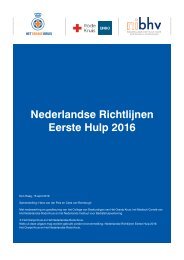Thesis-Anne-Vos-Masters-SBR-and-EU-Law-3
Thesis-Anne-Vos-Masters-SBR-and-EU-Law-3
Thesis-Anne-Vos-Masters-SBR-and-EU-Law-3
Create successful ePaper yourself
Turn your PDF publications into a flip-book with our unique Google optimized e-Paper software.
5.3 General principle: transparency principle<br />
5.3.1 <strong>EU</strong> level<br />
The transparency principle is the newest principle of the <strong>EU</strong> general principles. It has been the<br />
subject of debate whether this principle should actually be considered as a general principle of<br />
Union law. The CJ<strong>EU</strong> has confirmed this for the first time in the case Commission v Italy. 244 This<br />
position is also argued in literature. According to Buijze, the principle should be considered as a<br />
general principle of Union law; although mostly seen in certain areas, such as in procurement law,<br />
it is applicable in the entire legal system. 245<br />
There is no general acknowledged definition of the principle. It appears in several subject areas<br />
<strong>and</strong> contexts <strong>and</strong> it overlaps many other general principles such as legal certainty, equality <strong>and</strong><br />
principle to state reasons. Several authors give different definitions. The general meaning of the<br />
principle, according to Buijze, is that the information on government action should be available in a<br />
clear, obvious <strong>and</strong> underst<strong>and</strong>able way. 246 According to Prechal & De Leeuw "the more precise<br />
meaning of transparency depends on the context in which it is used, the function it is expected to<br />
fulfil <strong>and</strong> therefore also the interests it is aiming to protect." 247 The manner in which the<br />
transparency is justified by the underlying aims <strong>and</strong> objectives, the more weight could be attributed<br />
to the principle. 248 There are several appearances of the transparency principle which appear in all<br />
general <strong>EU</strong> law areas, such as transparency in the sense of an open <strong>and</strong> accountable government,<br />
clarity of procedures, clear drafting <strong>and</strong> the obligation to state reasons. There are also some<br />
specific <strong>EU</strong> law areas in which the appearance of the transparency principle has been crystallised,<br />
such as in the area of public procurement. This latter application is also finding its way into the<br />
area of scarce licenses <strong>and</strong> decisions. These specific areas will not be elaborated in more depth<br />
here. Although public procurement is part of the granting of shale gas extraction licenses, that part<br />
is not the focus of this thesis <strong>and</strong> will therefore be left aside here. Moreover, the transparency<br />
principle is much broader than only its application in public procurement.<br />
The first appearance mentioned ('open <strong>and</strong> accountable government') is the most-developed<br />
aspect of the transparency principle <strong>and</strong> includes the access to information in environmental law.<br />
With regard to this appearance of the transparency principle, Prechal & De Leeuw argue that it<br />
mostly functions at two 'levels' (or perspectives): at the political or constitutional level (closely<br />
related to the principle of democracy <strong>and</strong> legitimacy) <strong>and</strong> at a more concrete administrative level<br />
(closely related to the right to be heard <strong>and</strong> rights of defence). 249 Buijze also distinguishes two<br />
aspects: first, the aspect that the transparency principle facilitates decision-making <strong>and</strong> second,<br />
that it allows an outsider to observe what a transparent organisation is doing. 250 These are more or<br />
less the same functions as referred to by Prechal & De Leeuw. First a short comment on the<br />
second level to which Prechal & De Leeuw refer. This level relates to the rights of the defence.<br />
Here, the right of access to the file comes into play. This right is derived from the condition of<br />
procedural fairness, the principle of equality of arms <strong>and</strong> the right to be heard. 251<br />
Better known is the first level of this appearance. This concerns the right of public access to<br />
information. The notions of democracy, legitimacy <strong>and</strong> political accountability are closely linked<br />
here, for which the transparency principle could be seen as a pre-condition. 252 The connection of<br />
244<br />
Case C-260/04 Commission v Italy [2007] ECR I-07083.<br />
245<br />
Buijze (2011), p. 241.<br />
246<br />
Buijze (2011), p. 241.<br />
247<br />
Prechal & De Leeuwen (2008), p. 202.<br />
248<br />
Buijze (2011), p. 241.<br />
249<br />
Prechal & De Leeuwen (2008), pp. 204-205.<br />
250<br />
Buiijze (2013), p. 54.<br />
251<br />
Prechal & De Leeuwen (2008), p. 209.<br />
252<br />
Prechal & De Leeuwen (2008), p. 205.<br />
58



